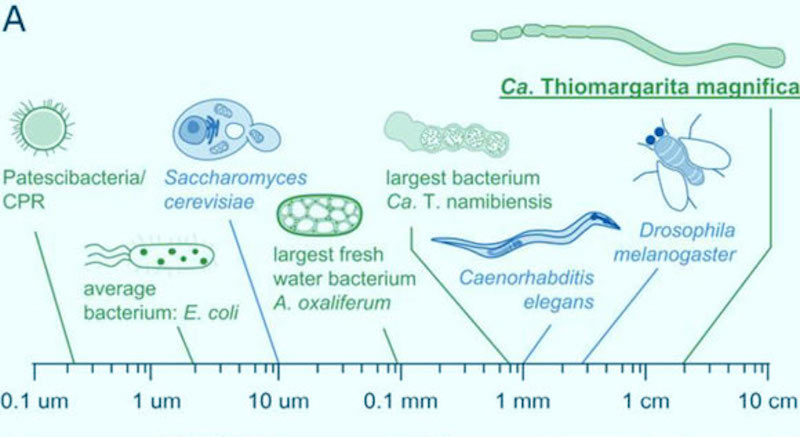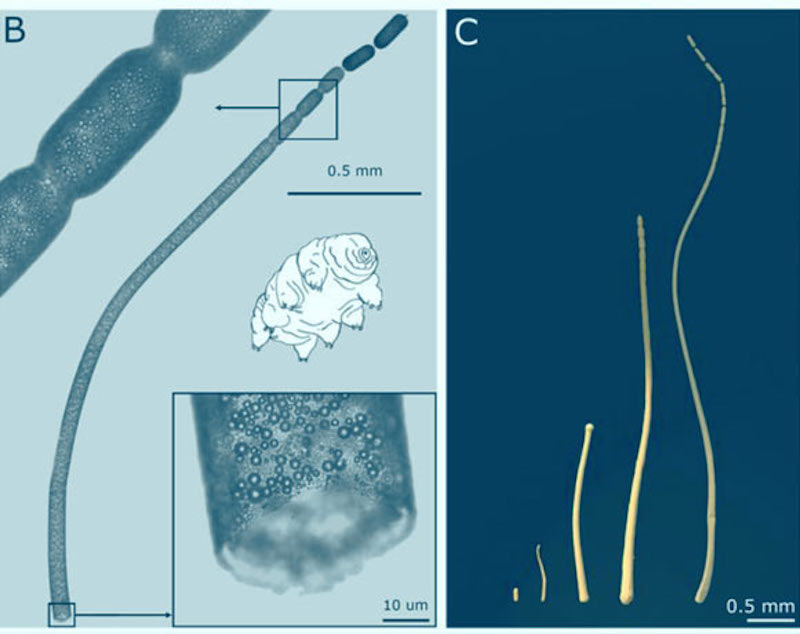
When we think of bacteria, we think of microbes, organisms so small that they can’t be seen with the unaided eye. And that’s true. But on June 23, 2022, scientists announced that they’ve identified a species of bacteria that is 50 times larger than the previously largest known bacterium. In fact, it reaches up to about 0.4 inches (1 centimeter) in length, easily seen by the unaided eye!
The researchers published their discovery in the peer-reviewed journal Science on June 23, 2022. A free preprint version of the paper is also available on bioRxiv.
Bacteria and archaea are the most diverse and abundant organisms on Earth. In 2019, scientists even found bacteria that eat and breathe electricity! So perhaps it’s not too surprising to find bacteria that are a lot bigger than usual, too.
Giant bacterium not recognized at first
Scientists discovered the bacterium – called Thiomargarita magnifica – in shallow tropical marine mangroves in Guadeloupe, Lesser Antilles, in the Caribbean. Guadeloupe is an archipelago and overseas department and region of France.
When researchers first found it in 2009, they didn’t realize it was a bacterium. Due to its large size, researchers thought it was possibly a species of eukaryote. Eukaryotes are single-celled or multicellular organisms whose cell contains a distinct, membrane-bound nucleus. Silvina Gonzalez-Rizzo at the University of the Antilles stated that:
I thought they were eukaryotes; I didn’t think they were bacteria because they were so big with seemingly a lot of filaments. We realized they were unique because it looked like a single cell. The fact that they were a ‘macro’ microbe was fascinating!
Olivier Gros, a professor at the University of the Antilles, added:
When I saw them, I thought, ‘strange.’ In the beginning I thought it was just something curious, some white filaments that needed to be attached to something in the sediment like a leaf.

Giant bacterium is nearly 1 centimeter long
Thiomargarita magnifica is huge for a bacterium, at nearly a centimeter long. Or more specifically, the researchers measured the filaments at up to 9.66 millimeters long. Basically, 0.4 inches (10 mm or 1 cm). That’s 50 times larger than any other of the biggest known bacteria. Gros said:
Such bacterial giants raise the question of whether more macro-bacteria might still be out there but have not yet been identified. Some exceptional members of sulfur-oxidizing gammaproteobacteria Thiomargarita namibiensis, for instance, are known to reach up to 750 micrometers (average size of 180 micrometers). While most model bacteria and archaea are small, some remarkably large cells, referred to as giant bacteria, are evident in at least four phyla and have cellular sizes in the range of tens or even hundreds of microns.
Filaments are single cells
At such a size, it’s easy to think that these filaments must be made of many individual cells. But no, the filaments of Thiomargarita magnifica are one giant cell. This is similar to other large sulfur bacteria. The researchers used various microscopy techniques, such as hard X-ray tomography, confocal laser scanning microscopy and transmission electron microscopy to study the new bacterium.
While the filaments are one single cell, each cell does contain novel, membrane-bound compartments. Those compartments contain clusters of DNA. The researchers named these compartments “pepins,” after the small seeds found in fruits (also called pips).

Lead author Jean-Marie Volland, a researcher at DOE’s Joint Genome Institute, Lawrence Berkeley National Laboratory and the Laboratory for Research in Complex Systems, commented:
Ca. Thiomargarita magnifica contains three times more genes than most bacteria and hundreds of thousands of genome copies (polyploidy) that are spread throughout the entire cell.
The mangrove ecosystem
Not only is this bacterium fascinating in itself, it also provides new insights into its role in the mangrove ecosystem. Holland said:
In terms of metabolism, it does chemosynthesis, which is a process analogous to photosynthesis for plants.
There are still unanswered questions, of course. Do the pepins play a role in the evolution of Thiomargarita magnifica’s extreme size? Are the pepins also present in other bacterial species?

As noted in the paper:
Through its gigantic cell size, its large genome, its di-morphic life cycle, but most importantly through its compartmentalization of genetic material in membrane-bound pepins, Ca. Thiomargarita magnifica adds to the list of bacteria that have evolved a higher level of complexity.
It is the first and only bacteria known to date to unambiguously segregate their genetic material in membrane-bound organelles in the manner of eukaryotes and therefore challenges our concept of a bacterial cell.
Bottom line: Scientists say they have discovered the largest species of bacteria ever found. The giant bacterium, called Thiomargarita magnifica, is about 0.4 inches (1 centimeter) long. Scientists discovered it among shallow tropical marine mangroves in Guadeloupe, Lesser Antilles, in the Caribbean.











